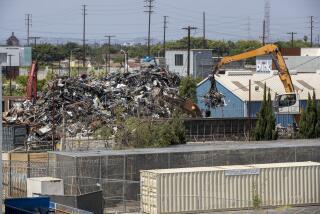Also Silver, Copper and Gold : Montana Town Thrives on Getting the Lead Out
- Share via
EAST HELENA, Mont. — This tiny town has one of the few lead smelters on earth capable of processing lead ore that also contains varying amounts of silver, copper and gold. The others are in Canada, Europe and Japan.
Since the depletion of Montana’s deposits more than 40 years ago, most of the ore is shipped from mines in Peru, Bolivia and Australia to the Asarco Inc. smelter here. Less than 5% of the ore now originates in Montana mines.
Freight cars carrying the ore roll into East Helena every day on the Burlington Northern Railroad. The foreign ore, more than half of which comes from Peru, is carried by ship to Tacoma, Wash., where it is loaded onto freight cars. Other trains bring the material from lead mines in Canada and elsewhere in the United States.
Important Role in Area
Melvin A. Sharp, a metallurgical engineer and Asarco’s plant manager, noted that the huge smelter just east of Helena, Montana’s capital, is the area’s largest industrial plant, employing 304 men and women with an annual payroll of $9 million.
It has played an important role in the economy of the Helena region ever since it opened in 1889, the year that Montana became a state. A decade later, American Smelting & Refining was organized and the East Helena smelter became one of its original units. Today the corporation is known as Asarco.
The smelter reduces the ore to liquid form in a 2,200-degree blast furnace. The copper, which collects on top of the molten metal, is skimmed off and sent to a copper smelter in Hayden, Ariz., for further processing.
The rest of the metal flows out of the furnace and is pumped into molds to cool and solidify. The resulting blocks--10 feet long, 4 feet wide, 18 inches tall and weighing 10 tons--are called bullion.
Lead Market Devastated
Every day, freight cars leave the Asarco smelter loaded with bullion destined for the Asarco refinery at Omaha, where the large cast blocks are melted and separated into lead and other metals.
The lead market was devastated in recent years with the removal of lead from most gasoline in the United States. Lead was also formerly used for shielding on telephone cables and in paint.
Today, the largest single use for lead is the lead acid storage battery found in every car, bus and truck.
Last year, the East Helena smelter processed 70,000 tons of lead, 17 million ounces of silver, 70,000 ounces of gold and 7,000 tons of copper from the ore shipped here. Lead currently sells for 20 cents a pound.
When lead took a nose-dive on the marketplace nine lead smelters in the United States closed.
However, despite the now-restricted market for lead, 1985 “was a good year,” Sharp said. “The plant generated $10 million in profits. This year the market is much tougher. . . . Prices are lower and flat. We are struggling to keep in the black.”
More to Read
Sign up for Essential California
The most important California stories and recommendations in your inbox every morning.
You may occasionally receive promotional content from the Los Angeles Times.













